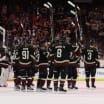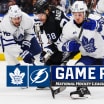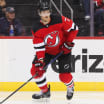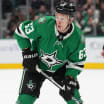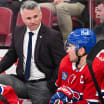SAN JOSE -- Brent Burns is on a roll. He's riffing, and the smile is creeping across his face, his missing teeth flashing and his beard flying. He's laughing, amused at himself and his teammate and all the possibilities.
Sharks headed for playoffs, new identity minus Marleau, Thornton
Postseason will be major test for San Jose without mainstays
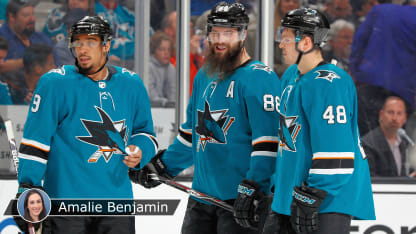
"Holograms," the San Jose Sharks defenseman suggests, nodding toward media relations manager Ben Guerrero. "We need the full body shot with Jumbo. We need the full effect of Jumbo. We need to design that."
He's envisioning a future for the Sharks without Joe Thornton. Except, in this vision, Thornton is still there, hovering over them and their dressing room, never very far away. He has beamed up his once -- and apparently forever -- teammate, fashioning him into an enduring presence.
It's difficult to imagine it any other way. It's difficult to imagine the Sharks without Thornton, even though they have been without the injured center since Jan. 23. His presence looms, perhaps because even as he has been away rehabbing and not on the ice, he has still been there.
There's no void. Not yet.
"He's around," Burns said. "He's not here, [but] we're FaceTiming him before games."
Seriously?
"Oh yeah, he's around, all the time," Burns said. "He's always with us."
But he won't be on the ice when the Sharks begin the Stanley Cup Playoffs. Nor will Patrick Marleau.
General manager Doug Wilson and the Sharks have been preparing for this moment, working and planning, drafting and developing a future set of stars, trading for uber-talented forward Evander Kane, laying down a blueprint for what comes next.
That time is now, perhaps earlier than expected, after Marleau signed with the Toronto Maple Leafs on July 2, and after Thornton was injured. And so now it is time for the results, for the potential to become so much more than that.
The Sharks will have to win, at least at first, on the backs of Marleau and Thornton's heirs: Burns and forwards Joe Pavelski, Logan Couture and Kane. Thornton won't be around to help them, FaceTime sessions notwithstanding. But, in a way, he'll be there.
Thornton and Marleau, like Wilson, spent years preparing the Sharks for this moment, building a culture and a legacy, teaching lessons about acting as professionals, about freedom of expression, about having fun. About turning the Silicon Valley philosophy into one that can work for the team based in Silicon Valley.
"Those guys have led the way and established something," said Pavelski, the San Jose captain. "[We] try to keep that going and keep passing it on.… We always look up to those guys in a lot of ways. You don't replace that. You don't push that aside."
They didn't want it to happen this way, but the Sharks of the future are getting a test run now.
And so, it needs to be asked, who are they, these new Sharks? And how good can they be?
\\\\
When Marleau arrived, the Sharks were six seasons into their existence. They had made two appearances in the Stanley Cup Playoffs, winning a round in 1994 and another in 1995.
They were a new team, in a part of the country not known for hockey, lacking an identity.
That changed with Marleau, the farm boy from the 75-person town of Aneroid, Saskatchewan, who was chosen No. 2 in the 1997 NHL Draft, and who helped the Sharks make the playoffs 17 times in his 19 seasons in San Jose. He, and the Sharks, got an additional boost on Nov. 30, 2005, when they acquired Thornton -- who had gone No. 1 in that draft -- from the Boston Bruins. The trade shook up both teams and set the stage for the next decade in San Jose.
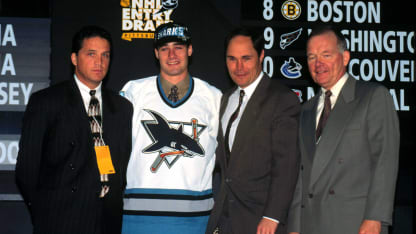
© B Bennett/Getty Images
For so long, it would be Marleau and Thornton, Thornton and Marleau, culminating with their first trip to the Stanley Cup Final in 2016.
"To have two personalities like that, two guys who are kind of different personalities, yet such competitive guys, you needed that," said Bruins forward Tommy Wingels, who was selected by the Sharks in the sixth round (No. 177) of the 2008 NHL Draft and played with them until being traded to the Ottawa Senators last season.
"That's why hockey got off the ground there."
But time breaks down everything, bodies and dreams and connections. It breaks up dynasties and ushers in new ones. It turns what could be into what has been.
"That's eventually what it's going to come to," said defenseman Marc-Edouard Vlasic, who arrived in San Jose as a rookie in 2006-07. "When we had both last year, yeah, we'd like to keep them as long as we can, but eventually, the Sharks will have to move on from those two names."
They knew that, inevitably, they would have to transition away from Marleau, their all-time leader in goals (508), points (1,082) and games played (1,493), and Thornton, their all-time leader in assists (745). They knew that they would have to find a new group, begin a new era.
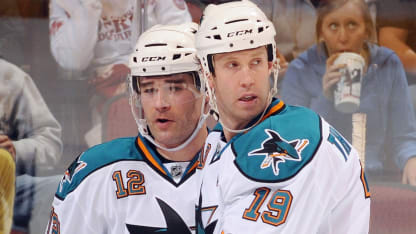
© Norm Hall/Getty Images
Three years ago, the Sharks moved their American Hockey League team from Worcester, Massachusetts, to San Jose, rechristening them the San Jose Barracuda. They play at SAP Center, sharing a rink and an outlook with the NHL team.
"That was a big piece of the puzzle for us," Wilson said.
The Sharks are better able to oversee their prospects, introduce them to a piece of what it is like to be in the NHL. The Washington Capitals were recently practicing at SAP Center, and there were the Barracuda players, watching Alex Ovechkin and Braden Holtby, getting a glimpse at their future and a push from their present.
The Sharks roster is peppered with young players, with forwards Joonas Donskoi (25), Tomas Hertl (24), Timo Meier (21), Kevin Labanc (22) and Chris Tierney (23), and defensemen Joakim Ryan (24) and Dylan DeMelo (24), all players who had not hit kindergarten when Marleau (38) and Thornton (38) were drafted.
"They knew when we brought the Barracuda out here, these young guys were going to be given the chances," Wilson said.
This is their chance.
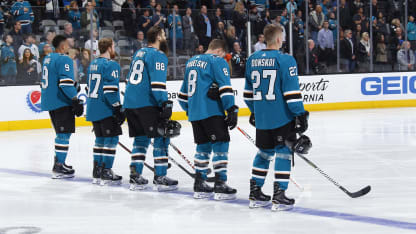
© Rocky W. Widner/NHL/Getty Images
They are the ones who will be on display when the playoffs open, when the curtain rises. It will be their moment and their team, something they have been working for and playing for and anticipating.
It was why the Sharks did not bring any outside players in on professional tryout contracts at the start of the season, wanting to make sure the young players knew that if they put in the work, if they had the skill, it would be their time.
It was the way the League was going, getting younger and faster, a new generation of stars arising from the old, giving them a sense that, as defensemen Brenden Dillon put it, "those two guys that have been here for so long [are] kind of passing the torch on."
But transitions are not always pretty. Often, they are painful and ugly, with years of losing as they turn into rebuilds. The Sharks did not envision theirs happening that way, and so far it has not. Marleau is gone, and Thornton is out, and yet the Sharks (44-25-10) are second in the Pacific Division and bound for the Stanley Cup Playoffs.
"I think the question in the last couple years was, are guys ready to pass the torch?" Wingels said "Are we, as an organization, comfortable having our young guys become more of an integral part of the team? Do we have confidence in these young guys? Ultimately, it's on those young guys to decide that.
"I think the past year or two there were questions, can guys like Chris Tierney, Tomas Hertl continue to get better? Logan Couture is a heck of a player, can he continue to get better and be the guy in San Jose? I think a lot of those questions were answered."
The questions were answered. The players found a place. The organization brought in help, most recently in the form of Kane, who has been spectacular for the Sharks with 14 points (nine goals, five assists) in 16 games, to bolster the homegrown players, the Barracuda grown up.
"People will talk about the torch being passed or windows," Wilson said. "I'm not sure a window is closed, but another one might open. There's a difference."
But even as that window opens, as the transition moves forward, there is still an open spot, vacated by Marleau and, at least for now, by Thornton. There is a position that needs to be filled, whether by a young, flashy player, a veteran finally getting his due or a star brought in from the outside.
There needs to be a face.
\\\\
Tierney noticed the silence. The chatter was gone, the room dimmed.
The injury had taken out Thornton, with damage to his right medial collateral ligament that required surgery and an extended absence (he is out indefinitely). It had also taken out his teammates, put a pall on a usually cheerful group. Thornton had always been there, filling the room and the bus and the planes with his infectious personality -- and his beard.
But not on that day.
"It was definitely really quiet in the room when he first went out," Tierney said. "It was a different feeling for sure."
It didn't take long to fill the emptiness. Burns stepped in and stepped up, and his voice turned the calm into chaos.
"Probably one game, then [Burns] was cracking some jokes," Tierney said. "It was a little weird, the first game or two, but then you just settle in and it's back to business."
That, perhaps, is always the way. Marleau leaves, and Thornton remains. Thornton is out, and Burns remains. The Sharks cycle through their players, and move on to the next prospect, the next generation, the next face, the next legend.
"When we started the year without [Marleau], people were like, OK, Jumbo's still here," Vlasic said. "Jumbo goes down, then people really get to see what the Sharks will look like when they're not here."
And that, perhaps, starts with Burns. Many of the Sharks' other key players -- Vlasic, Pavelski, Couture -- are more understated, less vocal, less apt to be the focus of national attention and ad campaigns, as much as they might deserve them.
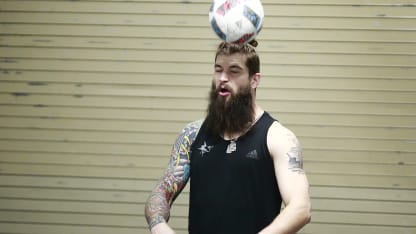
© Jeff Vinnick/Getty Images
Burns, meanwhile, is all big laughs and odd customs and loud suits. He is, as he even admits, a creation in the mold of Thornton, one whose personality was allowed to shine because there was a star already just that outlandish.
But even as he was learning at the foot of Thornton, he did not have to take on all the responsibility. There were still voices that carried louder than his, players who were relied on. Burns could be the court jester. Now, he needs to do more, to provide leadership along with his levity, the way Thornton did for so long.
"I think sometimes we get into this sport and if you're smiling and laughing, you're not doing your job or you're not taking it seriously enough," said Burns, 33. "But when you get to play with a guy that is going to go down as one of the legends of the game and he has fun every second of it, he's laughing, he's dancing on the bench, he's having a blast on the on the bus, it's huge.
"You lose a game, you feel like you're at the bottom of the earth, you feel like a [jerk] and he's laughing on the bus. It makes it easier to say, 'Hey, this is a pretty good life. There's going to be another day.' I think that's the atmosphere he's created."
\\\\
The No. 19 Thornton and No. 12 Marleau jerseys still dominate SAP Center and downtown San Jose. But there are others too, Burns' No. 88 and Hertl's No. 48 and maybe, if he sticks around, Kane's No. 9 will be added to the mix (he can become an unrestricted free agent July 1). This is how a team evolves; as players slip away, as new ones take their places, as time marches on.
Not everything changes. The lessons and the legacy and the culture remain, for this group of Sharks players, and the next. Thornton begat Burns, and Burns will eventually beget someone else.
"These guys definitely set a standard for the way you play and carry yourself here," Tierney said. "It's a winning franchise and you're expected to win every year. They set the table for us."
But there are no guarantees, and that is where these playoffs become a test. For the Sharks, and for Wilson, as the Sharks grapple with their future, finding a way forward as their past is slipping away.
Because these playoffs will be their challenge as they try to determine whether they're ready for the succession plan or whether there is more work to be done. Wilson's job was to craft a team that could survive the eventual losses of Marleau, which has happened, and Thornton, which for now is temporary but will one day be permanent.
Though, as Wilson said, "We want him to be a Shark, always a Shark, and there will always be a place in the organization for him."
But not always on the ice.
"There is a transition," Capitals coach Barry Trotz said. "Time passes and guys get older and you get to a new group of guys. There's been a transition in San Jose for the last couple of years, allowing some of the leadership to fall on the shoulders of some of the younger guys.
"The leadership that's come before them, in the Marleaus and Thorntons, still have impact to this day. And even when Joe's not in the lineup he still has impact in that room."
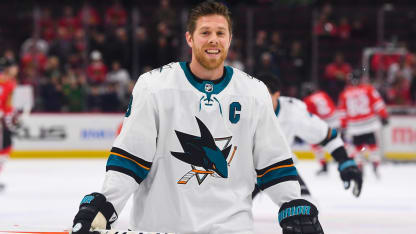
© Icon Sportswire/Getty Images
He will, for a long time.
"Joe Thornton is a huge part of this organization," Wilson said. "Patty Marleau was a huge part of this organization, creating the standards and culture that we expect. And our next layer of guys -- Logan Couture, Joe Pavelski, Brent Burns, (goaltender) Martin Jones, Marc-Edouard Vlasic, (defenseman) Justin Braun -- have come through that environment."
The next wave is coming. Players once in the shadow are moving to the fore. New stars are budding, new faces are emerging, and it is time to see what all of that amounts to, what this team is, what will come in the years ahead.
They have learned from their predecessors, and now it's time to take those lessons to heart, to demonstrate what they have learned. It will be a crucial test for Wilson and for the Sharks of their readiness to compete, to move to the next level, even without their most recognizable faces.
Can they make another run to the Stanley Cup Final? Can Kane get them there? Can Burns? Can the young players, the next generation, fulfill the legacy that neither Marleau nor Thornton has, by finally bringing a Stanley Cup championship to San Jose?
This is their time. This is their moment. This is when they find out who they are now, and who they can be.

